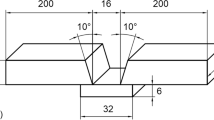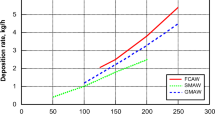Abstract
Since the 1970s, bismuth has been widely used as an auxiliary ingredient in stainless steel flux-cored wires to improve slag detachability. But for components subject to post weld heat treatment (PWHT) and/or applications at high temperature, bismuth has been confirmed to have a negative effect on weld metal ductility. There are also reports on cracks found in such weldments after service at elevated temperatures. For this reason, specifications recently started limiting the weld metal bismuth content. API RP 582, for instance, has included a maximum bismuth content of 20 ppm in the weld deposit when welding with austenitic stainless steel flux-cored wires for applications above 538 °C, including PWHT. This new demand required development of a new range of flux-cored wires intended for overlay welding (cladding) of creep resistant steels and joining stainless steels for high temperature applications. The fillers that have been developed include the alloys E347, E309 L, and E308H. Two types for each alloy are available: One is optimized for welding in flat/horizontal position, and the other features a fast-freezing slag system supporting the weld pool when welding in other positions. The mechanical properties obtained in all-weld metal, V joints, and weld overlay applications with the newly developed wires are compared with standard wires. The effect of the chemical composition on welding behavior and slag detachability is discussed and some examples are given where these specific flux-cored wires can be used in the oil and gas industry.
Zusammenfassung
Bismut wird seit den 1970iger Jahren weit verbreitet als Zusatzstoff in Fülldrähten eingesetzt um den Schlackenabgang zu verbessern. Für Bauteile, die jedoch einer Wärmebehandlung nach dem Schweißen unterzogen werden oder auch bei höheren Temperaturen eingesetzt werden, wurde ein negativer Einfluss von Bismut auf die Zähigkeit des Schweißgutes gefunden. Es wurden auch Risse in Schweißnähten entdeckt, die höheren Einsatztemperaturen ausgesetzt waren. Daher wird in manchen Spezifikationen bereits eine Beschränkung des Bismut-Gehaltes in Schweißgütern vorgeschrieben. Zum Beispiel wird in der API RP 582 ein maximal zulässiger Bismut-Gehalt von 20 ppm im Schweißgut genannt, wenn mit Fülldrähten geschweißt wird und die Anwendungs- oder Wärmebehandlungstemperatur über 538 °C liegt. Diese Anforderung erforderte eine Neuentwicklung von Fülldrähten, die für Plattierungen von kriechbeständigen Stählen und zum Verbindungsschweißen von korrosionsbeständigen, austenitischen Stählen für höhere Temperaturen eingesetzt werden. Die neu entwickelten Schweißzusatzwerkstoffe umfassen die Legierungen E347, E309 L und E308H. Zwei Typen pro Legierung sind verfügbar: eine optimierte Variante für das Schweißen in Wannenlage (waagrechtes Schweißen) und eine optimierte Variante mit schnell erstarrender Schlacke für das Positionsschweißen. Die mechanisch-technologischen Eigenschaften im reinen Schweißgut, im V-Verbindungsschweißgut und Plattierungsanwendungen der neu entwickelten Fülldrähte werden mit jenen der Standard-Schweißgüter verglichen. Der Einfluss der chemischen Zusammensetzung auf das Schweißverhalten und den Schlackenabgang wird diskutiert und einige Anwendungsbeispiele für den Einsatz dieser speziellen Fülldrähte in der Öl- und Gasindustrie aufgezeigt.






Similar content being viewed by others
References
Farrar, J. C. M; Marshall, A. W.; Zhang, Z.: Position statement on the effect of bismuth on the elevated temperature properties of flux-cored stainless steel weldments, Weld World, 45 (2001), no 5/6, pp 25–31
Chemical plant welding research committee of the Japan engineering Society (JWES): High temperature damage to stainless steel welds made by flux-cored arc welding and its analysis, Proceedings, API 61th Fall Refinery Meeting, 1996, pp 21–23
Nishiyama, S.; Mashushita, Y.; Maruyama, T.: Flux-cored wires for stainless steel welding, Weld World, 36 (1995), pp 103–123
Hara, Y. et al.: High temperature damage to stainless steel welds made by flux cored arc welding and its analysis, Proceedings, API 61st Full Refinery Meeting, Houston, TX, USA, 1996
Nishimoto, K.; Matsunaga, T.; Tanaka, T.; Okazaki, T.: Effect of bismuth on reheat cracking susceptibility in type 308 FCAW weld metal, Weld World, 41 (1998), pp 220–235
Konosu, S.; Hashimoto, A.; Mashiba, H.; Takeshima, T.; Ohtsuka, T.: Creep crack growth properties of type 308 austenitic stainless steel weld metals, Weld J, 77 (1998), no. 8, pp 322 s-327 s
Kotecki, D.: Welding Journal Stainless Q & A, March (2008), p. 54
Marshall, A. W.; Farrar, J. C. M.: Type ‘308H’ austenitic stainless steel wed metals for high temperature service. Proceedings, Stainless Steel World ’99 Conference, The Hague, The Netherlands, 1999
American Petroleum Institute Recommended Practice: API RP 582 “Welding Guidelines for the Chemical, Oil, and Gas Industries”, 2nd Edition, Dec. 2009
AWS A5.22:2012. A8.1.4: Bismuth (Bi) in Flux Cored Stainless Steel Electrodes
Godrej Process Equipment Division specification, Welding Engineering: WCPS for SMAW Consumables and FCAW wire, WCPS/130615–130641, 2008, 3 pp
Acknowledgements
C.E. Cross at Los Alamos National Laboratory, Los Alamos, New Mexico, gave valuable comments on the script.
Author information
Authors and Affiliations
Corresponding author
Rights and permissions
About this article
Cite this article
Westin, E.M., Schnitzer, R., Ciccomascolo, F. et al. Stainless Steel Bismuth Free Flux-cored Wires for High Temperature Applications. Berg Huettenmaenn Monatsh 160, 426–433 (2015). https://doi.org/10.1007/s00501-015-0403-0
Received:
Accepted:
Published:
Issue Date:
DOI: https://doi.org/10.1007/s00501-015-0403-0




